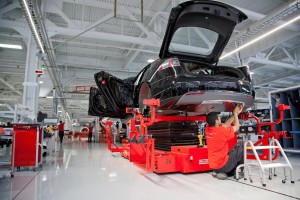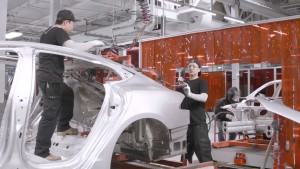
Tesla is shutting down its plant temporarily to resolve production problems that have delayed Model 3 production.
Tesla is temporarily idling its troubled Fremont, California assembly plant for as long as five days, the automaker has confirmed, in order to “improve automation and systematically address bottlenecks.”
The factory, originally built by General Motors, is Tesla’s only automotive manufacturing facility and currently produces the company’s three battery-electric vehicles, the Models S, X and 3. The latter EV is Tesla’s first “affordable,” long-range vehicle and is meant to push the company into the mainstream – and its balance sheet into the black.
But the factory has been in what CEO Elon Musk calls “production hell” since the first Model 3 rolled off the line last July, running up unexpected deficits and leading some to question the company’s very survival.
There has been much debate over what has gone wrong. Some analysts point to fundamental design problems with the Model 3 itself, while others focus on Tesla’s failure to properly test out the Fremont assembly line before formal production began. Tesla itself has cited issues at the company’s Reno, Nevada Gigafactory that provides the Model 3 battery packs.
(Musk promises Tesla profits in second half of this year. Click Here for the story.)
But CEO Musk has also acknowledged that Tesla may have tried to move too aggressively towards what some have dubbed a “light’s out,” heavily automated plant.
“Yes, excessive automation at Tesla was a mistake,” Musk tweeted on Friday. “To be precise, my mistake. Humans are underrated.”
According to various reports, the more highly automated areas of the Fremont and Gigafactory plants have been the source of some of the biggest delays in Model 3 production.
It is unclear precisely what Tesla plans to do during its four- to five-day production shutdown in Fremont, but a spokesman for the company said, “These periods are used to improve automation and systematically address bottlenecks in order to increase production rates.”
Tesla has a long history of missing production targets. It fell a full two years behind schedule before launching the Model X battery SUV – and it still has major quality and reliability issues that led Consumer Reports magazine to declare it the most troubled new model now in production.
The Model 3 made its launch date but little else has gone right ever since. Most of the vehicles built in 2017 were largely hand-assembled. And while production did ramp up sharply during the first quarter of this year, the line rate barely hit 2,000 a week by the end of March, 20% below the 2,500 weekly production rate Tesla officials promised just a few months ago.
(Click Here for details about Tesla being hit with NLRB complaints over firings.)
The current goal is to reach 5,000 Model 3s a week by the end of the second quarter. But it is now all but impossible the company will come close to full-year goals of 500,000 vehicles, 80% of them Model 3 sedans.
As a result, many of the roughly 400,000 people who plunked down $1,000 deposits for early registrations will not take delivery until 2019, if even then, some analysts warn. Musk recently confirmed some potential buyers have sought their money back and some California Chevrolet dealers have reported selling similarly long-range Chevrolet Bolt EVs to frustrated Tesla customers.
For his part, Musk last week suggested that orders have simply gone into a “time shift.” Meanwhile he tweeted his expectations that the company will show both positive cash flow and a profit in the second half of 2018.
Not everyone buys that optimistic forecast, Tesla shares hovering well below 52-week highs as investors and some analysts start to grow wary. Many expect Tesla will have to raise further capital within the next year, especially if it continues to miss its sales targets for the Model 3.
And there are other issues challenging Musk and company. That includes a probe by the National Transportation Safety Board into a fatal crash of a Model X operating in semi-autonomous Autopilot mode last month. Tesla is also under fire by the National Labor Relations Board which is investigating the mass firing of almost 1,000 workers at the Fremont plant last year. Tesla claimed they were underperforming, but critics contend they were ousted because they openly supported a union at the factory.
(Waiting to take delivery of a Tesla Model 3? You might be caught in a “time shift.” Click Here for the story.)
The latest temporary shutdown could create further ill will, according to some observers. The website BuzzFeed, which first reported on the plant shutdown, now says workers will be required to either use vacation days or go without pay during the production halt.


“Musk recently confirmed some potential buyers have sought their money back…”. Interesting that the statement was not, ” Some potential buyers have received their $1000 deposit back.” Almost makes it sound as if Tesla isn’t exactly enamored with parting with needed cash.
To be honest, I’ve not been able to verify that cash is readily returned. Hoping to find some of these frustrated consumers.
Paul E.